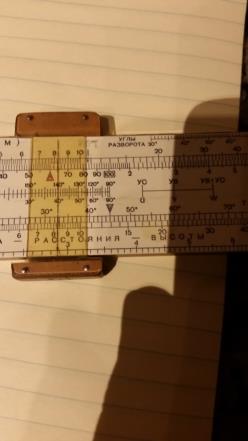
NavList:
A Community Devoted to the Preservation and Practice of Celestial Navigation and Other Methods of Traditional Wayfinding
From: Gary LaPook
Date: 2016 Nov 11, 18:11 -0800
Using the law of sines to compute the wind correction angle and ground speed for in-flight winds has been used for a long time with flight computers (slide rules.) Photo 1 shows a Russian flight computer. Working your example on this slide rule, photo 2 shows the cursor placed on the boat speed, 6.5 k, on the top scale (which is a logarithmic scale equivalent to a "K" scale since it covers three cycles.) Photo 3 shows the 30 degree mark on the sine scale on the slide (the center scale on the slide) lined up with the cursor. Photo 4 shows the cursor moved to the current speed, 2.3 k, on the "K" scale and you read out the current correction angle of 10 degrees on the sine scale. Photo 5 shows the cursor moved to 20 on the sine scale (30 degree relative current angle minus the current correction angle of 10 degrees) and reading out the speed over the ground (SOG) of 4.4 k. Photo 6 shows the cursor moved to 40 on the sine scale and reading out the SOG of 8.3 k.
Your results were:












